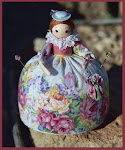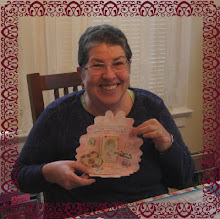Pin weaving is a simple way of creating a small woven piece without the use of a loom. It is weft faced weaving, that is, the warp thread will not show on the finished design. A design is created on graph paper and taped to a piece of foam core board. Pins are placed at the top and bottom of the design. A strong warp thread (waxed linen) is wrapped taughtly around each pin in a continuous motion. Weaving of the weft thread is done with a tapestry needle. Weft threads can be nearly any fiber, but for small pieces embroidery floss and pearl cotton work very well.

Here are a few websites to see examples of pin weaving for inspiration. Needleweaver.com has many examples of needle woven necklaces! Click on each artist to see more photos of their work. Most of these designs are more elaborate than a beginner would start with, but there are lots of ideas if you wish to continue with pin weaving. There are also lessons on this site; I did not follow these directions so they differ from mine. Note: above link no longer works, but I found LOTS of inspiration boards on Pinterest by searching "needle weaving" and "pin weaving."
An earlier article in Threads Magazine featured needle woven fabric inserted onto purse fronts. Very lovely, they are woven with heavier threads.
SIMPLE (and fun!) HOMEWORK BEFORE WORKSHOP: To start your design, you will need graph paper, 5 squares per inch. You can find graph paper on-line through Needlepointers.com.
This needlepoint website has a page listing places on the internet where you can find free graph paper. I used the second link listed and was directed to a site that lets you create all kinds of graph paper. There is a form on which you specify the number of squares per inch, it should be 5 squares per inch, or less.
When you have printed your graph paper, decide how large or small you would like your woven piece to be. On your graph paper draw borders around an even number of squares to accommodate your design. Do this several times on the page. Ten or 12 squares is a good size to start with. For my finished piece, above, I blocked off 10 squares. Here are my sketches (you should be able to enlarge the sketch by clicking on it):

You will be placing pins at the top and bottom of your design. At the top of each sketch, I like to number and make dots where the pins will be inserted later. If there are ten boxes, there will be 11 pins. So I number the dots like so:
5 - 4 - 3 - 2 - 1 - 0 - 1 - 2 - 3 - 4 - 5
Repeat at the bottom of the box. However, the pins at the bottom will be inserted between the vertical lines of the graph paper, therefore, only 10 pins will be used. I also number these dots, omitting the zero.
In the boxes you have drawn, make several sketches. You are not confined to the box shape; as you can see on my sketches -- and ones on the Needleweavers.com site listed above -- I sometimes went outside the border. It is simply easier, for a first project, not to go too wild.
Color in the sketches you like, and add beads to the sketch. Helen Banes, in her book “Beads & Threads,” says that beads are a focal point for the design, that is something to keep in mind when placing the beads.
The “don’t do like I did” section! On my first piece I changed colors at the top and bottom edges:

Not a good idea. When the piece comes off the board the sections will not stay together (just at these top and bottom edges). I realized this would happen before I removed the pins. It was easy to fix, though, so that could be an option if you really want color changes at the top and bottom. Here is how I fixed it. With the finished piece still attached to the board, I removed the first pin on the top right and wove a new length of weft thread through each of the warp loops at the top, removing each pin as I came to it, and adding a bead between each loop. This held the top edge together and also added a decorative row of beads. Repeat at the bottom.
Supplies for class which I will provide
(kit cost approx. $5):
Foam core board, 1/2 inch thick
Tapestry needles, small to large
Pins
Waxed linen for warp
Supplies students should bring to class:
Graph paper (please see website above to print your own graph paper) PLUS bring your finished sketches
Embroidery floss or pearl cotton
Beads (with large holes preferred)
Things you will need to finish your project, probably after class:
Beacon Fabric-Tac
Ultrasuede for backing
Pinback (to make a brooch), or beads & beading thread (to make a necklace)
All the supplies students are to bring to class are available in Oxford. Wal-Mart has a good selection of beads, including ones with large holes (please look at the hole size before you buy), and other jewelry making supplies. The Fabric Center has a good selection of embroidery floss and also Beacon Fabric-Tac.
Here are some glass beads I picked up at Wal-Mart which have holes large enough to pull 2 warp threads through:

Please bring your finished sketches, beads and embroidery floss to the workshop on March 28, at 6:00. If you have any questions, please call me (number in phone book).
















No comments:
Post a Comment